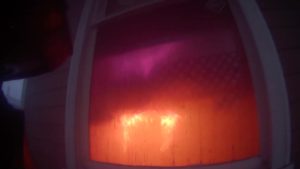In this video, we have a fire in the far corner of the living room and somewhat shielded from the reach of the stream both due to distance and the fact that the room is L shaped.

The fire was allowed to grow to the point that it filled the living room and started to push into the kitchen. However, we never got much presentation into the kitchen because most of the pressure went up the stairs to floor two.
The chief on the outside said it looked more like a rocking floor two fire than a floor one fire. This brings to mind the Stilt Court near miss. Remember, no matter how sure you are that the fire is on floor two you must clear all of floor one before committing up the stairs. In this burn, had the kitchen door been closed the kitchen would have remained totally clear.
The fire attack situation is similar to a burn we did last year in Ferndale. A large open room with lots of heat and smoke. (See Jay’s write up “Ferndale Kitchen Split”). We know from experience that in these larger rooms we need to really cool those overhead surfaces by methodically washing the line back and forth across the ceiling and working it forward and that we need to put a large amount of water downrange.
In this video, we see the nozzle person only flow for a few seconds at a high angle before performing two circles downrange. Then they shut down. The total flow time was less than four seconds. As they attempt to move forward we see fire rolling over them to the kitchen doorway in only a few seconds. This is no surprise since the ceiling and the gasses were never sufficiently cooled and not enough water was put down range to knock the fire down. While they were able to gain control by flowing again, the heat they took was unnecessary. This also allowed additional heat and fire to travel up the stairs towards the bedrooms.
Since the seat of the fire was somewhat in line with the nozzle person and they were not comfortable yet with the flow and move skill set this student was directed before the fire to hit and move. Remember that even a hit must be long enough to cool all surfaces and gain control of the space you are moving into. Long hits must be practiced intentionally. The seconds should be measured in training otherwise students will inevitably perform short hits. Under the excitement and pressure of a real fire attack, three seconds feels like forever.



